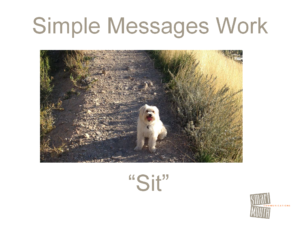by Beth Levine | Apr 26, 2019 | preparing for a presentation, public speaking
 What do you say when you want to give a brief but impactful overview of your business and your brand?
What do you say when you want to give a brief but impactful overview of your business and your brand?
You’ve got to go high. Or do what I call “going up to 30,000 feet and looking down.” Take the biggest-picture view you can find on your organization’s work and its value. Or, as President George H. W. Bush is known to have called it, find that “vision thing.”
The view from 30,000 feet is the exact opposite of peering through the weeds, and while most people in an organization are by definition, and indeed by assignment, stuck in the day-to-day weeds, certainly a leader is in a position—and arguably has the responsibility—to rise to a higher vantage point.
For an example of a 30,000-foot view, let’s look at one of my clients, an entrepreneurial company that manufactures super high-end sports equipment. The executives came to me for spokesperson training in advance of what they expected to be a busy season of trade shows and sport competitions where their products and sponsored athletes would attract a lot of attention. The engineering and technology that goes into the production of their equipment is as fascinating as it is dense with detail and data. Yet for the media—and for the benefit of building and promoting the brand—they needed to develop some higher-level messaging. The nitty-gritty details could be saved for the trade journals that craved them.
In a small group session with the executive team, I asked a series of questions to elicit the 30,000-foot view. Fundamentally, I was pushing and poking at them to home in and identify what their company is really all about. It’s not about the product line or producing the best equipment; it’s not about being made in America; it’s not even about satisfied customers. Those are all great attributes, but they’re closer to the ground (where weeds grow). What the 30,000-foot exercise yielded in the end was that their company is all about three things, characterized in a different way: innovation, performance, and fun.
Having a 30,000-foot view of your organization’s work in your back pocket means you’re always prepared to speak at the higher visionary level befitting a leader. It gives you a go-to point when you need to make remarks that describe your work and its value. Ultimately, it’s more memorable and communicates your brand … rather than just your product line.
[Excerpted in part from Jock Talk: 5 Communication Principles for Leaders as Exemplified by Legends of the Sports World, www.jocktalkbook.com]
by Beth Levine | Mar 31, 2019 | preparing for a presentation, public speaking

“Vision trumps all other senses.”
Those are the words of Dr. John Medina, a renowned molecular biologist. I have been fascinated by his book, “Brain Rules: 12 Principles for Surviving and Thriving at Work, Home, and School” for a while now.
According to Medina’s work, we remember pictures. He claims that if we hear a piece of information without a picture as visual support, then three days later we’ll remember only 10% of it. However, if we hear a piece of information with a picture to support it, then three days later we’ll remember 65% of it.
Medina also asserts that we remember pictures much better than we remember text, because our brains see words as lots of little pictures, making the reading part less efficient than simply looking at a picture.
The implication for business presentations? Images beat words. Those dense text slides you’re using or seeing might not be providing the “visual support” benefit you were hoping they would have.
Try images – pictures, simple graphics, or even one-word slides. It takes some forethought and advance planning, but your audience will better remember what you were trying to impart.
And, if you spare them the multi-bullet-pointed slides that have become ubiquitous, they are likely to thank you.
by Beth Levine | Jan 15, 2019 | preparing for a presentation, public speaking
 When you prepare for a presentation, can you picture it in your mind’s eye? Do you know the elements of your opening or how you’re going to transition between your main points? Can you see it in your head, or do you need your notes?
When you prepare for a presentation, can you picture it in your mind’s eye? Do you know the elements of your opening or how you’re going to transition between your main points? Can you see it in your head, or do you need your notes?
A presentation isn’t as much a seamlessly flowing narrative as it is a deliberately well-constructed set of building blocks. For our discussion purposes here, let’s call those building blocks “chunks.” If you can chunk your material, then you have something modular, which is more easily abbreviated if your audience runs out of time and also easier for you to remember and deliver.
So what would the critical chunks of a presentation be and how would you construct them? I’m glad you asked!
First, you’ll need an opening chunk. This might include a question that stimulates the audience’s thoughts and connections to your topic. Or it might include a story that illustrates the importance of your topic. Or it might just be a simple introduction to the topic. Either way, your opening also needs to include a one-sentence focal point, in which you tell the audience what you want them to do (call to action) or to take away (impression, piece of knowledge) by the end.
Next, you’ll need to identify up to three key points. By “up to” I mean one, two or three points – and not three and a half, four or five. Yes, this means you’ll have to prioritize. You’ll be lucky if your audience can remember three, or two, or even one. So if you’re presenting with the intention and hope that your audience will retain what you say, then set a maximum of three key points. Each of your key points then becomes its own chunk, which means that with the opening chunk and up to three more, you have a maximum of four things to remember so far and you’re almost done!
Here are the ingredients of each of your “key point” chunks:
- A message statement that captures significance and/or conveys benefit for this section of your material.
- Some information points (data, detail, background) that support the message statement and that are prioritized and chosen based on your audience’s needs and interests.
- For good measure, and as a springboard to transition to your next chunk, each key point chunk should conclude with a reinforcement of the opening message statement.
Finally, your last chunk is your closing. Closing elements can include a recap of key point message statements; a story that illustrates the importance of your talk; and a circling back to your focal point to ensure that the audience knows what to do or think when they leave the room.
If you have the ability to picture five bullet points in your mind, you can see the chunks too. Try it and let us know how it goes!

by Beth Levine | Jan 2, 2019 | preparing for a presentation, public speaking

Most of us hit a personal reset button or two on the 1
st of January. But even if you aren’t someone who makes specific resolutions, you probably still view the new year as a blank slate, a chance to start fresh.
Let me help you get off to a fresh start for your first presentation of the year by offering a SmartMouth Top 10 list on this first Thursday of 2019:
10. You know this: Do your homework. Nothing drastic, just prepare ahead. If you think through your material rather than wing it, it will show and reflect well on you.
9. There’s no right or wrong, but there is better and worse. When in doubt, make decisions about your content, your visuals and the amount of time you’ll take based on your own experiences as an audience member. In other words, do unto others …
8. No one likes a windbag. Share the floor. Figure out ways to engage your audience and create opportunities for dialogue. Present, don’t broadcast.
7. Whatever you think is noticeable and distracting about you – your voice, hair, nose – it’s not. Unless you’re a paid spokesmodel, the audience isn’t paying attention to your specific physical features or your voice quality. They want to feel your confidence and hear your content.
6. Your content may be amazing, but your audience can only digest and retain some of it. Please prioritize all that great knowledge and information of yours so that you deliver something useful and memorable to your audience.
5. Present, the verb: to give something. Present, the noun: a gift. Figure out what you can give to your audience that would be a good gift – i.e. something new, useful, beneficial, valuable. Give them something good in exchange for their time and attention.
4. Your nerves are just adrenaline. They are your body’s way of surging positive energy for you to do a good job. Not to worry, studies show that nerves begin to dissipate after two minutes – that’s only 120 seconds.
3. Don’t dread your presentation, as if it’s some unpleasant obligation. Find your ambitious self and embrace your presentation as a great opportunity to advance – yourself, your organization or a goal. Go for it, don’t shrink from it.
2. Be organized: know your audience, know the lay of the land (number of people, room set-up, mic or no mic) as best you can, and know your desired outcome for the presentation. The first two help you envision what to expect. The third helps you know – if you prepare nothing else – how to set the audience’s expectations and where you need to get them by the end.
– and –
1. It’s all about them, it’s not about you. Your audience’s needs and experience supersede your own. Plan your presentation around them, not around yourself or your deep knowledge and expertise. Success is in the eye of the beholder, and that’s your audience. Make them #1.

by Beth Levine | Dec 4, 2018 | preparing for a presentation, public speaking
 If there were ever an invitation to “wing it” in public speaking, it would be when you’re invited to speak on a panel.
If there were ever an invitation to “wing it” in public speaking, it would be when you’re invited to speak on a panel.
Or would it?
I think this is worth discussing …
For sure, the glory/work quotient of participating on a panel is high. On the glory side, panels are great public speaking opportunities. You’re usually matched with other notables in your field, sometimes with those more notable. You get great exposure and access to a new audience. And you get to share your best nuggets of genius without bearing full responsibility for filling the time.
On the work side, the heavy lifting is typically low. Except in cases where the panel is structured, and specific subsections of the topic are assigned, most panels tend to flow freely once introductions and perhaps opening remarks are made. They’re often moderated or facilitated, there are plenty of prompts to remind you exactly what to talk about, and there’s always someone to bail you out or fill an uncomfortable silence if you trail off, forget what you were about to say, or have only a few words to offer. Sweet!
So, prepare or wing it?
To answer this dilemma, I think you need to ask yourself why you said yes in the first place. What drew you? Was it a close colleague or friend who invited you? Was it the location of the event? (ProTip: Say yes to panels in Hawaii.) Maybe it was the opportunity to get in front of a particular audience? Or maybe you said yes because the topic is so near and dear to you, speaking about it on a panel would be a breeze, almost second-nature.
Your motivation for accepting the invitation informs but shouldn’t really affect your decision to prepare or not. Would it do you great harm not to prepare? Probably not. Would it benefit you greatly not to prepare? Probably not. In other words, there’s a decent probability that not preparing has a net neutral effect. You don’t really lose, you don’t really gain.
But let’s be honest here. Net neutral is not the typical effect you look to have in your career, is it? You spend a lot of time building – your network, your reputation, your expertise, your visibility. It’s probably fair to say that if you’ve said yes to a panel invitation, there’s some net gain you’ve identified. Therefore, at least some preparation is warranted.
To that end, let’s look at some ways to prepare that don’t take a lot of time but may pack a lot of punch:
Must-air points. Given the topic, there are likely points you do not want to forget to share with the audience. Think of it as a collection of your most important thoughts on the topic – your “greatest hits” – and jot them down in bullet point form.
Differentiators. Surely you have ideas, theories, discoveries, concepts or philosophies that are unique to you/your work and would distinguish you with the audience. Decide which ones you want to share and add them to your bullet points.
Stories. You most definitely have stories – examples, anecdotes, and/or drama-filled sagas – you can share. Pick your best ones and add those to the bullet points as well. Two tips on stories: 1) unless you identify and shape/practice them in advance, you’re unlikely to conjure up and tell the perfect story on the spot; and 2) stories need to be matched up with a point you’re making, in which the point becomes the punchline to the story.
The risks associated with winging it – rambling, hemming and hawing, searching your brain for the right things to say, losing your train of thought – are too great. Being prepared – with a definitive beginning and end to your points and good stories to illustrate those points – conveys confidence, command and polish. All you need is a few bullet points and you can post your next panel in the gain column!

by Beth Levine | Oct 25, 2018 | preparing for a presentation, public speaking, quote
 There is considerable debate about attention spans and about the effects of the digital world and handheld devices. Interestingly enough, just a few decades ago, the debate focused on the effect that television was having on attention spans. Digital devices like smartphones and tablets are just the latest and greatest scapegoats. Whether they have or haven’t contributed to diminishing attention spans, it is certainly mind-boggling to realize that, with Twitter, full-bodied messages can be delivered in 140 characters or less.
There is considerable debate about attention spans and about the effects of the digital world and handheld devices. Interestingly enough, just a few decades ago, the debate focused on the effect that television was having on attention spans. Digital devices like smartphones and tablets are just the latest and greatest scapegoats. Whether they have or haven’t contributed to diminishing attention spans, it is certainly mind-boggling to realize that, with Twitter, full-bodied messages can be delivered in 140 characters or less.
The change in attention spans is often discussed in negative terms, as a deterioration in our ability to focus. But I think we have to ask ourselves, is this really a bad thing? I prefer to look at the phenomenon as a market disruption or correction that is forcing communications to adopt the often-touted corporate principles of leanness and efficiency. As companies try to increase engagement and productivity, improving communication—by cutting out waste—could be quite effective. Being brief and to the point may require a little extra effort, but it can accomplish a lot and save precious time.
Many studies have now measured adult attention spans—where they are and how they’ve changed over the years. There are reports suggesting that in just the last decade, the average adult attention span has shrunk from highs of twelve to eighteen minutes and to lows of three to five minutes, depending on the study’s focus and the environments of the participants. Some studies look at how long people can concentrate on a task; others look at their attentiveness while listening. Yet how long people can pay attention to a speaker depends on tremendous variables that can make it hard to measure: the comfort and conduciveness of the environment, the speaker’s voice quality and modulation, the actual content, whether there are effective visuals or good stories, what the objective is for the audience, and whether they understand that objective. The ability to focus is, after all, crucial to the achievement of an objective, so audience motivation levels can vary as well.
Holding the attention of an adult audience requires a tremendous amount of multitasking and careful advance planning. In other words, brevity—or perhaps we should call it efficiency and expediency—in communication takes discipline and planning. As the speaker, it’s up to you to do the hard work of organizing your thoughts and packaging your content for your audience, because their attention spans are what they are and they’re not growing!
(Excerpted in part from Jock Talk: 5 Communication Principles as Exemplified by Legends of the Sports World)
 What do you say when you want to give a brief but impactful overview of your business and your brand?
What do you say when you want to give a brief but impactful overview of your business and your brand?

 When you prepare for a presentation, can you picture it in your mind’s eye? Do you know the elements of your opening or how you’re going to transition between your main points? Can you see it in your head, or do you need your notes?
When you prepare for a presentation, can you picture it in your mind’s eye? Do you know the elements of your opening or how you’re going to transition between your main points? Can you see it in your head, or do you need your notes?
 Most of us hit a personal reset button or two on the 1st of January. But even if you aren’t someone who makes specific resolutions, you probably still view the new year as a blank slate, a chance to start fresh.
Most of us hit a personal reset button or two on the 1st of January. But even if you aren’t someone who makes specific resolutions, you probably still view the new year as a blank slate, a chance to start fresh.
 If there were ever an invitation to “wing it” in public speaking, it would be when you’re invited to speak on a panel.
If there were ever an invitation to “wing it” in public speaking, it would be when you’re invited to speak on a panel.
 There is considerable debate about attention spans and about the effects of the digital world and handheld devices. Interestingly enough, just a few decades ago, the debate focused on the effect that television was having on attention spans. Digital devices like smartphones and tablets are just the latest and greatest scapegoats. Whether they have or haven’t contributed to diminishing attention spans, it is certainly mind-boggling to realize that, with Twitter, full-bodied messages can be delivered in 140 characters or less.
There is considerable debate about attention spans and about the effects of the digital world and handheld devices. Interestingly enough, just a few decades ago, the debate focused on the effect that television was having on attention spans. Digital devices like smartphones and tablets are just the latest and greatest scapegoats. Whether they have or haven’t contributed to diminishing attention spans, it is certainly mind-boggling to realize that, with Twitter, full-bodied messages can be delivered in 140 characters or less.

